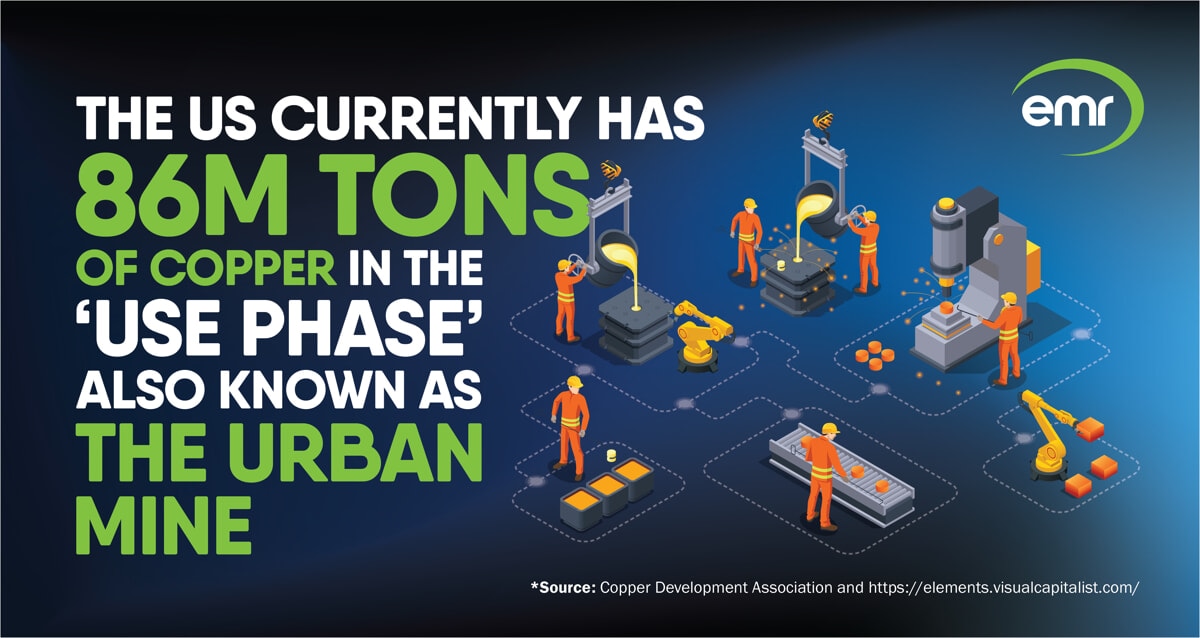CHOOSE
A DIFFERENT TERRITORY

Copper is having a moment. As more of our lives are enhanced by devices, smart technology, and the roll out of infrastructure such as renewable power, this versatile metal is in ever greater demand.
For the US to meet this demand and capitalize on the benefits these innovations can bring, it must make better use of the huge quantities of copper that can be found right here in our towns and cities.
This material bank is known as the ‘urban mine’ and extracting and reusing the materials within, including copper – which might otherwise be exported – comes with the twin benefits of boosting US resource security and reducing the environmental damage that production of virgin metals cause.
The urban mine represents a huge opportunity for recovering copper, as has been outlined by a new report – The State of Copper Recycling in the U.S. – produced by the Copper Development Association. The US currently has 86 million tons (mt) of copper in the “use phase” which contributes to the urban mine. This includes buildings (45.4mt), infrastructure (16.1 mt), consumer products (11.2mt), transport (8.5mt) and industry (4.8 mt).
Yet the report also outlined some of the many challenges the industry will face in unlocking this material for use by US manufacturers. Chief among these is the large number of contaminants that can reduce the quality of semi-finished recycled copper. The majority of this material is contaminated by aluminum, iron, lead, and tin, but 22% of shipments are also co-mingled with highly toxic arsenic – highlighting just how difficult it can be to produce high grades of recycled copper.
This level of contamination has a very real economic impact. The report calculates that manufacturers of semi-finished copper and copper alloys spend, on average, $28,000 per month on testing and analysis of their products and reject 25 shipments of contaminated scrap per year.
These companies also spend, on average, an additional $58,000 per month to address production and product quality issues caused by undetected contaminants in scrap.
As the US seeks to develop and roll out the next generation of smart devices and green technologies, removing these contaminants – via increased secondary smelting and refining capacity – will be a crucial building block towards a more resilient US copper supply chain. In fact, the growing demand for more complex grades of copper will see capacity for secondary smelting expand by 280,000 tons in the next few years.
This marks a historic – and very welcome – pivot after decades in which valuable copper scrap has been exported in ever greater quantities.
Exports of this material soared – and have continued to rise – since the last secondary smelter in the US was shut down at the turn of the millennium. By 2022, the US exported half of the 1,569,000 tons of copper content generated from scrap – in large part due to the lack of secondary smelting capacity capable of processing complex scrap grades into furnace-ready raw materials.
Expanding production of the highest grades of recycled copper in the US will provide new jobs, boost the US’s resource security in an increasingly uncertain world and help achieve many of the ambitious carbon reduction targets facing manufacturers in the years ahead.
And while using more high-quality recycled copper has many advantages, the increased demand for copper means it poses little challenge to producers of virgin copper.
As copper can last for decades – in buildings, vehicles, or infrastructure projects – there is a significant lag time before this material becomes available for recycling. Primary production will therefore continue to play a crucial role in meeting the increased demand for copper.
Keeping more of this valuable metal right here in the US makes sense for so many reasons and, as a world leading metal recycler, EMR is ready to work with our customers, partners, and other stakeholders to turn this vital ambition into a reality.